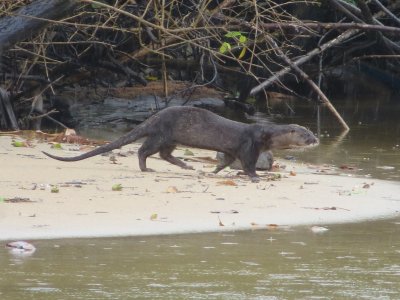IUCN/SSC Otter Specialist Group Bulletin

|
©IUCN/SCC Otter Specialist Group Volume 30 Issue 2 (October 2013) Citation: Latifiana, K. and Pickles, R.S.A. (2013). New Observation of the Hairy-Nosed Otter (Lutra sumatrana) in Sumatra. IUCN Otter Spec. Group Bull. 30 (2): 118 - 122 New Observation of the Hairy-Nosed Otter (Lutra sumatrana) in Sumatra Kurnia Latifiana1, 2 and Rob S.A. Pickles3, 4
1Tambling Wildlife Nature Conservation, Pengekahan, Way Haru Village, Bengkunat Belimbing Subdistrict,
West Lampung, Lampung Province, Indonesia |
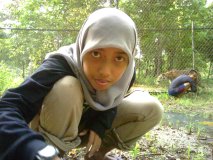
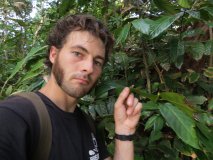 |
| Received 2nd July 2013, accepted 20th October 2013 |
| Abstract:An adult hairy-nosed otter (Lutra sumatrana) was photographed by the authors in Tambling Wildlife Nature Conservation, a privately managed concession within the Bukit Barisan Selatan National Park in southern Sumatra. This observation represents the southern-most record of the L. sumatrana’s known range and is only the second time in the last fifty years that the species has been recorded in Sumatra. |
| Keywords: Lutra sumatrana, Sumatra, Tambling |
| Française | Español | Bahasa Indonesia |
The hairy-nosed otter (Lutra sumatrana) is the world’s rarest otter species and its cryptic habits coupled with the difficulty of reliable identifications in the field mean that we lack a good understanding of where the species occurs. The historical distribution stretches from northern Myanmar, South Thailand, Cambodia, South Vietnam, Peninsular Malaysia, Sumatra and Borneo ( Figure 1 ) ( Duckworth and Hills 2008 ; Wright et al., 2008 ; IUCN 2013 ). Evidence of the species’ continued occurrence in the Malay Archipelago come from recent camera trap footage in Sabah, northern Borneo ( Wilting et al., 2010 ), while the only record of the species in Sumatra in the last fifty years was a road-kill from Sekayu, Palembang, South Sumatera Province ( Lubis 2005 ). The new record is from the southern tip of the Bukit Barisan Selatan National Park, Lampung Province (S 50 51’ 38.1” E 140 33’ 37.0”) ( Figure 1 ). This is 350km south of the 2005 observation and the southern-most record of the species
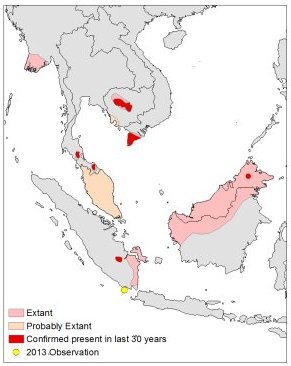 |
| Figure 1. Sighting location map (click for larger version) |
The observation was made at 10.02 am, 10th March 2013 at an estuary mouth on the west coast of Tambling. The otter was first seen at a distance of 50m from the observers, approximately 20m from the high tide line, the animal remaining unaware of our presence as we approached to within 25m. The total duration of the observation was probably no more than five minutes. The otter scent marked a log and groomed itself on the sand before swimming across the river and heading into the swamp. We identified the species from photographs taken at the time based on its large slanted nostrils, furry rhinarium and stark white patches on its lower lip ( Figure 2 )
The firm sand did not yield good prints, but one impression of a forepaw had a width of 57mm and a length of 59mm ( Figure 3 ). Only four toes were visible. The largest toe had a width of 10mm and the pad with was 21mm. In the fairly symmetrical print the claws were distinct but the interdigital webbing was not visible. Kanchanasaka (2001) reported average forepaw track widths of 58mm from a sample of 23 observations.
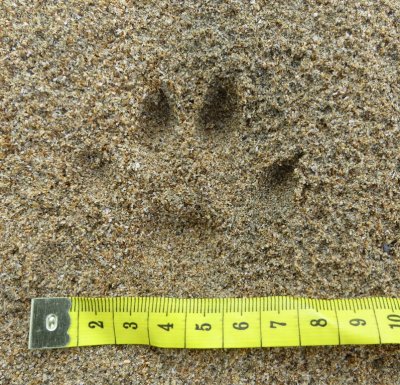 |
| Figure 3. Forefoot print made by L. sumatrana during the observation. (click for larger version) |
The habitat around the estuary is flooded swamp dominated by nypa palm (Nypa fruticans) and mangroves (Bruguiera sp., Avicennia sp.) with banyans (Ficus microcarpa)palms (Pandanus tectorius) and baringtonia (Baringtonia asiatica) also present, consistent with previous observations of L. sumatrana,whichhave mostly been made in swamps and flooded lowland forest ( Wright et al., 2008 ) ( Figure 4 ).
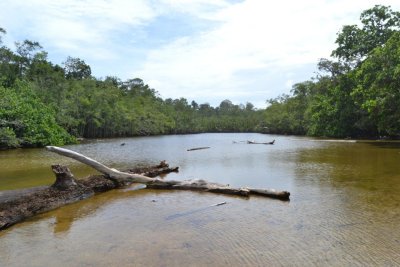 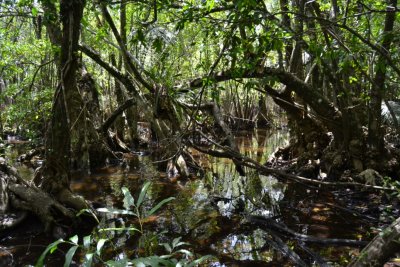
|
| Figure 4. The habitat where the otter was observed (above): the estuary mouth closed by a sand bank and (below) the mangrove swamp further upriver. (click for larger version) |
In southern Thailand and Vietnam the species has been found in peat swamp forest, with cores of Melaleuca (Melaleuca cajuputi) ( Kanchanasaka, 2001 ; Nguyen et al., 2001 ). The only other recent record of L. sumatrana in Sumatra was in an area of flooded open swamp and palm oil plantation ( Lubis, 2005 ). In March the dry season begins in southwestern Sumatra and as the flow rate of the rivers reduces, leading to the mouths of many of the small rivers flowing into the sea become backed up by sand banks, creating a series of temporary lagoons. The Cukuh Babui lagoon appears to offer good hunting potential for prey of L. sumatrana with dog-faced water snake (Cerberus rynchops) and mangrove cat snake (Boiga dendrophylla) common. Water snakes have been reported to represent as much as 18% of the diet of L. sumatrana ( Kanchanasaka, 2001 ).
Tambling could represent an important site for the conservation for L. sumatrana in Sumatra due to the park’s extensive nypa dominated swamps and lagoons along its west and southern coast coupled with the effective control of human encroachment and hunting.
Acknowledgements - We are grateful for the generous support of Tambling Wildlife Nature Conservation and Mr Tomy Winata personally. We are also grateful for the support of the Ministry of Forestry of the Republic of Indonesia. We are thankful to Nicole Duplaix and Emmeliana Bujak for confirmation of the species identification.
REFERENCES
Duckworth, J.W., Hills, D.M. (2008).
A Specimen of Hairy-Nosed Otter Lutra sumatrana from Far Northern Myanmar
. IUCN Otter Specialist Group Bulletin 25: 60-67.
Francis, C.M. (2008).
A field Guide to the Mammals of South East Asia. New Holland Publishers, Singapore.
IUCN (2013). 2013 IUCN Red List of Threatened Species. Version 2013.1.
[Available from
www.iucnredlist.org
. Downloaded on 3 April 2013.]
Kanchanasaka, B. (2001).
Tracks and Other Signs of the Hairy-Nosed Otter (Lutra sumatrana)
. IUCN Otter Specialist Group Bulletin
18: 57-63.
Lubis, R. (2005).
First Recent Record of Hairy-Nosed Otter in Sumatra, Indonesia
. IUCN Otter Specialist Group Bulletin
22: 14-20.
Medway, L. (1969).
The wild mammals of Malaya and offshore islands including Singapore. Oxford University Press, London, UK and Oxford, UK
Nguyen, X.D., Pham, T.A., Le, H.T. (2001).
New Information about the Hairy-Nosed Otter (Lutra sumatrana) in Vietnam
. IUCN Otter Specialist Group Bulletin
18: 64-75.
Payne, J., Francis, C.M. (2007).
A field guide to the mammals of Borneo. The Sabah Society, Kota Kinabalu.
Wilting, A., Samejima, H., Mohamed, A. (2010). Diversity of Bornean viverrids and other small carnivores in Deramakot Forest Reserve, Sabah, Malaysia. Small Carnivore Conservation
42: 10-13.
Wright, L.C., Olsson, A., Kanchanasaka, B. (2008).
A Working Review of the Hairy-Nosed Otter (Lutra sumatrana)
. IUCN Otter Specialist Group Bulletin 25: 38- 59.
Résumé : Nouvelle Observation de la Loutre de Sumatra (Lutra sumatrana) à Sumatra
Une loutre de Sumatra adulte a été photographiée par les auteurs dans la réserve de Tambling, une concession privée dans le parc national de Bukit Barisan Selatan dans le sud de Sumatra. Cette observation représente l’observation la plus au sud de l’aire de répartition connue de Lutra sumatrana et seulement la deuxième observation des 50 dernières années de cette espèce à Sumatra.
Revenez au dessus
Resumen: Nueva Observación de la Nutria Sumatrana (Lutra sumatrana) en Sumatra
Se cita la observacion de dos especimenes de Nutria de Río de Nariz Peluda (Lutra sumatrana) en Sungai Tanum y Sungai Rengau, Taman Negara, Pahang, Península Malasia. Tratanse del tercer y cuarto registros formales de esta especie en Península Malasia desde la década de 1960, y el primer para Taman Negara en ese mismo periodo.
Vuelva a la tapa
Ringkasan: Pengamatan Baru Berang-Berang Hidung Berbulu (Lutra sumatrana) di Sumatera
Seekor berang-berang hidung berbulu (Lutra sumatrana) terfoto oleh penulis di Tambling Wildlife Nature Conservation, sebuah konsesi yang dikelola oleh swasta di dalam Taman Nasional Bukit Barisan di selatan Sumatera. Pengamatan ini merupakan catatan sebaran paling selatan dari L. sumatrana dan merupakan catatan penemuan kedua kalinya jenis ini selama lima puluh tahun terakhir yang tercatat di Sumatra.
Kembali ke atas
